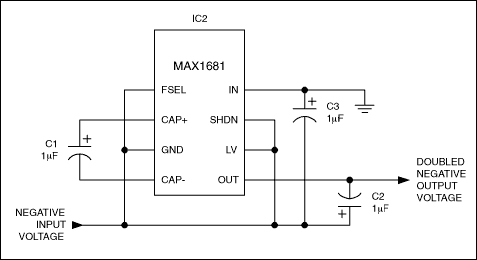Charge Pump Doubles Negative Voltage
For low-power dc-dc circuits, the small size and high efficiency of charge pumps makes them ideal for simple doubling and inverting applications. The absence of such ICs designed for negative voltage, however, requires that you adapt an existing positive-voltage device.

Figure 1. This standard charge-pump application inverts a positive input voltage.
Offsetting the voltage levels in a positive-voltage inverter converts it to a negative-voltage doubler, as shown in Figure 2. Connect the inverter's input to ground and its ground to the negative voltage to be doubled. The resulting circuit requires only three external capacitors to double a negative voltage between 2.0V and 5.5V.

Figure 2. This circuit (a modification of Figure 1) doubles negative input voltages between 2V and 5.5V.
Using low-cost 1µF capacitors for C1 and C2 (Figure 2) yields the output voltage drop versus load current curves shown in Figure 3. To reduce the output voltage drop exhibited by this circuit, increase the C1 and C2 capacitor values (in equal proportion). Doing so lowers the circuit's output impedance, and consequently its output voltage drop.

Figure 3. The VIN-VOUT differential for Figure 2 varies with output current as shown.
For a 5V input, the efficiency of this circuit at 100mA exceeds 85%. At 20mA, it exceeds 70%.